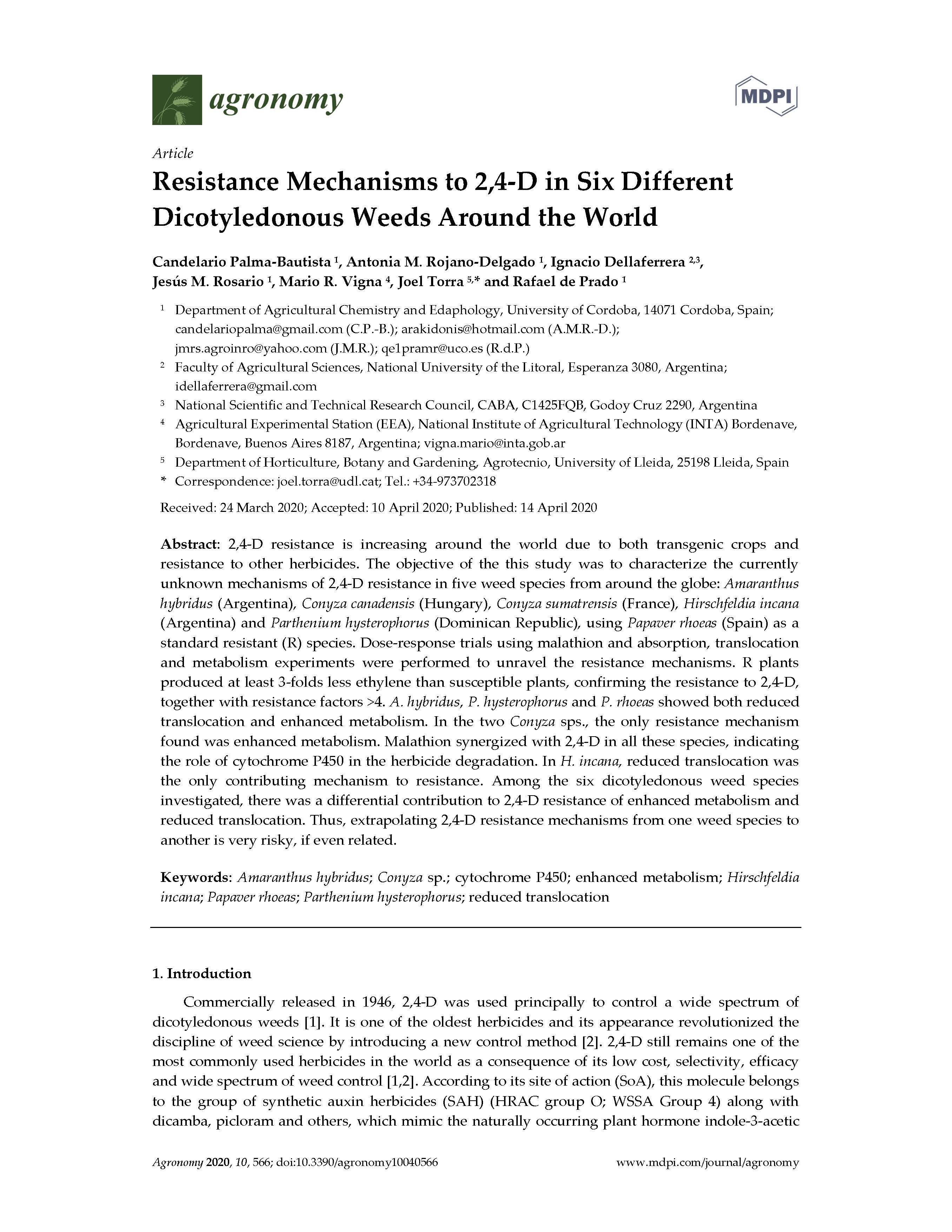Ver ítem
- xmlui.general.dspace_homeCentros Regionales y EEAsCentro Regional Buenos Aires SurEEA BordenaveArtículos científicosxmlui.ArtifactBrowser.ItemViewer.trail
- Inicio
- Centros Regionales y EEAs
- Centro Regional Buenos Aires Sur
- EEA Bordenave
- Artículos científicos
- Ver ítem
Resistance mechanisms to 2,4-D in six different dicotyledonous weeds around the world
Resumen
2,4-D resistance is increasing around the world due to both transgenic crops and resistance to other herbicides. The objective of the this study was to characterize the currently unknown mechanisms of 2,4-D resistance in five weed species from around the globe: Amaranthus hybridus (Argentina), Conyza canadensis (Hungary), Conyza sumatrensis (France), Hirschfeldia incana (Argentina) and Parthenium hysterophorus (Dominican Republic), using Papaver rhoeas
[ver mas...]
2,4-D resistance is increasing around the world due to both transgenic crops and resistance to other herbicides. The objective of the this study was to characterize the currently unknown mechanisms of 2,4-D resistance in five weed species from around the globe: Amaranthus hybridus (Argentina), Conyza canadensis (Hungary), Conyza sumatrensis (France), Hirschfeldia incana (Argentina) and Parthenium hysterophorus (Dominican Republic), using Papaver rhoeas (Spain) as a standard resistant (R) species. Dose-response trials using malathion and absorption, translocation and metabolism experiments were performed to unravel the resistance mechanisms. R plants produced at least 3-folds less ethylene than susceptible plants, confirming the resistance to 2,4-D,
together with resistance factors >4. A. hybridus, P. hysterophorus and P. rhoeas showed both reduced
translocation and enhanced metabolism. In the two Conyza sps., the only resistance mechanism found was enhanced metabolism. Malathion synergized with 2,4-D in all these species, indicating the role of cytochrome P450 in the herbicide degradation. In H. incana, reduced translocation was the only contributing mechanism to resistance. Among the six dicotyledonous weed species investigated, there was a differential contribution to 2,4-D resistance of enhanced metabolism and reduced translocation. Thus, extrapolating 2,4-D resistance mechanisms from one weed species to another is very risky, if even related.
[Cerrar]

Autor
Palma Bautista, Candelario;
Rojano Delgado, Antonia María;
Dellaferrera, Ignacio Miguel;
Rosario, Jesús M.;
Vigna, Mario Raul;
Torra, Joel;
de Prado, Rafael;
Fuente
Agronomy 10 (4) : 566. (2020)
Fecha
2020
Editorial
MDPI
ISSN
2073-4395
Formato
pdf
Tipo de documento
artículo
Palabras Claves
Derechos de acceso
Abierto
 Excepto donde se diga explicitamente, este item se publica bajo la siguiente descripción: Creative Commons Attribution-NonCommercial-ShareAlike 2.5 Unported (CC BY-NC-SA 2.5)
Excepto donde se diga explicitamente, este item se publica bajo la siguiente descripción: Creative Commons Attribution-NonCommercial-ShareAlike 2.5 Unported (CC BY-NC-SA 2.5)


